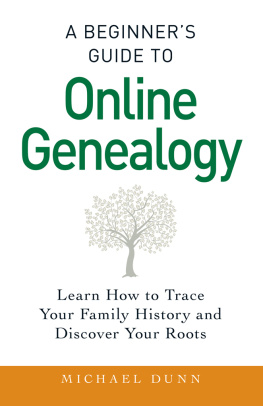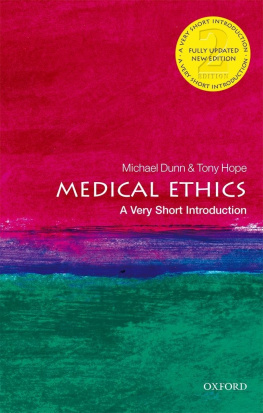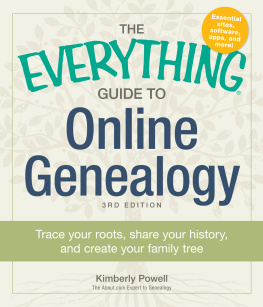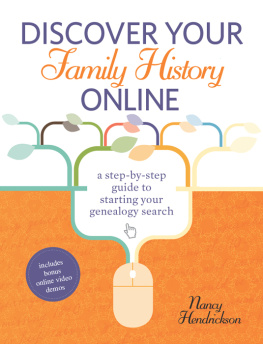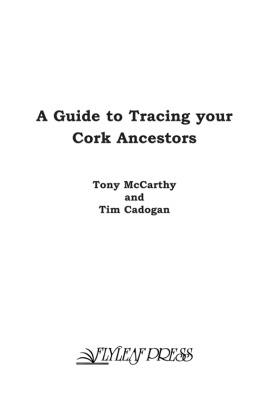Contents
Guide
A BEGINNERS
GUIDE TO
Online
Genealogy
Learn How to Trace
Your Family History and
Discover Your Roots
MICHAEL DUNN

AVON, MASSACHUSETTS
Contents
Introduction
Are you curious about the origin of your last name? Confused as to why your grandfather never spoke about his family? Do you want to know if you have a famous relative or a bit of scandal in your background?
Years ago, you could have spent thousands of dollars and countless hours thumbing through piles of paper in a distant town or even foreign countries trying to get to the bottom of your family history. Fortunately, times have changed and, today, you can access millions of historical records from the comfort of your own home with just the click of a mouse. But how do you search through all that data to find what you really need? How do you find information on your family, when theres so much out there? Thats where A Beginners Guide to Online Genealogy comes into play.
Packed full of easy-to-understand, cost-effective ways to fill out your family tree, this book takes you through the processstep-by-stepand teaches you how to use the Internet to plan your project, track down your family (even if they lived overseas), and share your findings with other genealogists or even long-lost family members. Youll even find invaluable information on free databases, the most popular genealogy apps, and moreall from the comfort of your couch!
In addition, youll learn how to use specialized software that makes it easy to keep track of hundreds or even thousands of tangled family connections. Youll see satellite images that can help you visualize the places where your ancestors once lived. And youll gain access to any number of online sites that can help you find military and death records, immigration passenger lists, and census reports to keep you moving forward.
As you search for your family history, youre guaranteed to make many discoveries along the way, both about your ancestors and about yourself. You may find that ancestors who led quiet, ordinary lives can be fascinating in their own special ways, and that history is much more interesting when you know that your ancestors were participants. And, once you learn about your familys history, youll be able to guarantee that your ancestors stories arent lost to time by memorializing them on any number of genealogy sites or even by displaying a beautiful rendition of your family tree in your home. After all, their stories are your stories, so start researching and figure out who you really are. Enjoy the journey!
CHAPTER 1
Where Should You Begin?
Millions of digitized images, from marriage certificates to military service records, can be viewed online. Published genealogies allow budding family historians to extend their family tree by generations in just a few minutes. There is even free online software available to help you record the information you find and build your family tree. Today, you can successfully use the Internet to plug into your past. Before you begin, however, you first need to learn a few tools of the tradethe symbols, terms, and conventions used by genealogists to collect, record, and communicate the relationships in a family tree. Some of the information presented in this introductory chapter may seem a bit complex at first, but after you spend a little time tracing your family tree it will all start to come together.
Plan Your Project
Why are you interested in your family history? Are you curious about the origin of your last name? Do you want to learn more about Great-Grandpas Polish roots? Are you hoping to identify as many of your ancestors as possible? Has an interesting story been handed down in your family that you want to pursue? Defining what you hope to learn on this journey is an important first step.
Even if your goal is to trace your entire family tree, it is practical to begin with one family line at a time. Otherwise, your research will quickly lead you into a bewildering maze of branching lineages. Go back just three generations in your own family tree, and youll find yourself faced with researching the genealogy of eight great-grandparents. One family tree has now branched into eight, and it continues to multiply from there. By the time youve worked your way through ten generations of your family, youll have discovered more than 1,000 ancestors!
Critical Clicks
As you research your family tree you may encounter numerous words with which you are unfamiliarwords specific to family history, as well as unfamiliar acronyms and legal and Latin terms commonly encountered in genealogical records. Look them up in online genealogy glossaries such as the ones listed under Specialized Dictionaries for Genealogists (http://genealogy.about.com/od/glossaries) on About.com Genealogy.
There are several different approaches you can take when beginning a family tree. A few of the more popular examples are detailed in the following sections, but pretty much anything related to researching something in the history of your family qualifies as genealogy. The format you choose to follow should be based on your individual research goals.
Direct Lineage
A direct lineage, alternately called a pedigree or ascendant tree, typically begins with you, a parent, or grandparent, and then follows a single surname or bloodline back through several generations in a direct line. This can also be expanded to include multiple direct lines, both of your parents, both of their parents, and so on. This is what most people think of when they refer to a family tree.
Family Lineage
Take the direct lineage family tree and throw in siblings; the siblings of your parents (your aunts and uncles), the siblings of your grandparents (your great-aunts and -uncles), and so on. This type of genealogy provides a more complete picture of the family going back through generations, rather than focusing only on the individuals from whom you directly descend.
Descendant Tree
A descendancy is the reverse of the traditional family tree. It usually starts with an ancestral couple pretty far back in the family tree and works forward to the present, attempting to account for all known descendants in all lines, both male and female. This is a popular approach for published family histories and for those looking to find relatives to plan a family reunion.
Collateral Genealogy
Basically an extension of the direct lineage, a collateral genealogy includes additional relatives who descend from the same common ancestor through lines other than your direct line, such as the spouses and children of siblings. This is similar to the descendant tree, except that most people use collateral genealogy as a type of cluster research approach (discussed in Chapter 2) to get around a brick wall in certain areas of their family tree, rather than because they are trying to document all descendants of a particular couple.
Whats Next? Basic Research Steps
The typical family tree often ends up incorporating elements of most of the approaches discussed in the previous section, so just consider these as a starting point for your research. The point is to begin by selecting a particular individual, couple, or family line that you want to research. Once youve selected this starting point, genealogy research follows a fairly standard set of steps:

